Endosomal acidification by Na+/H+ exchanger NHE5 regulates TrkA cell-surface targeting and NGF-induced PI3K signaling
- PMID: 24006492
- PMCID: PMC3814139
- DOI: 10.1091/mbc.E12-06-0445
Endosomal acidification by Na+/H+ exchanger NHE5 regulates TrkA cell-surface targeting and NGF-induced PI3K signaling
Abstract
To facilitate polarized vesicular trafficking and signal transduction, neuronal endosomes have evolved sophisticated mechanisms for pH homeostasis. NHE5 is a member of the Na(+)/H(+) exchanger family and is abundantly expressed in neurons and associates with recycling endosomes. Here we show that NHE5 potently acidifies recycling endosomes in PC12 cells. NHE5 depletion by plasmid-based short hairpin RNA significantly reduces cell surface abundance of TrkA, an effect similar to that observed after treatment with the V-ATPase inhibitor bafilomycin. A series of cell-surface biotinylation experiments suggests that anterograde trafficking of TrkA from recycling endosomes to plasma membrane is the likeliest target affected by NHE5 depletion. NHE5 knockdown reduces phosphorylation of Akt and Erk1/2 and impairs neurite outgrowth in response to nerve growth factor (NGF) treatment. Of interest, although both phosphoinositide 3-kinase-Akt and Erk signaling are activated by NGF-TrkA, NGF-induced Akt-phosphorylation appears to be more sensitively affected by perturbed endosomal pH. Furthermore, NHE5 depletion in rat cortical neurons in primary culture also inhibits neurite formation. These results collectively suggest that endosomal pH modulates trafficking of Trk-family receptor tyrosine kinases, neurotrophin signaling, and possibly neuronal differentiation.
Figures



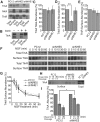


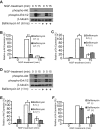
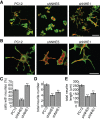
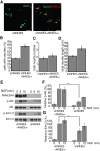
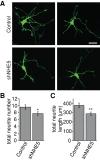
Similar articles
-
Endosomal Na+/H+ exchanger NHE5 influences MET recycling and cell migration.Mol Biol Cell. 2016 Feb 15;27(4):702-15. doi: 10.1091/mbc.E15-04-0257. Epub 2015 Dec 23. Mol Biol Cell. 2016. PMID: 26700318 Free PMC article.
-
Chloride channel 4 is required for nerve growth factor-induced TrkA signaling and neurite outgrowth in PC12 cells and cortical neurons.Neuroscience. 2013 Dec 3;253:389-97. doi: 10.1016/j.neuroscience.2013.09.003. Epub 2013 Sep 11. Neuroscience. 2013. PMID: 24036377
-
The small GTPase Rab7 controls the endosomal trafficking and neuritogenic signaling of the nerve growth factor receptor TrkA.J Neurosci. 2005 Nov 23;25(47):10930-40. doi: 10.1523/JNEUROSCI.2029-05.2005. J Neurosci. 2005. PMID: 16306406 Free PMC article.
-
Endosomal pH in neuronal signaling and synaptic transmission: role of Na(+)/H(+) exchanger NHE5.Front Physiol. 2014 Jan 13;4:412. doi: 10.3389/fphys.2013.00412. eCollection 2014 Jan 13. Front Physiol. 2014. PMID: 24454292 Free PMC article. Review.
-
Biogenesis and function of the NGF/TrkA signaling endosome.Int Rev Cell Mol Biol. 2015;314:239-57. doi: 10.1016/bs.ircmb.2014.10.002. Epub 2014 Nov 18. Int Rev Cell Mol Biol. 2015. PMID: 25619719 Free PMC article. Review.
Cited by
-
Live-cell Microscopy and Fluorescence-based Measurement of Luminal pH in Intracellular Organelles.Front Cell Dev Biol. 2017 Aug 21;5:71. doi: 10.3389/fcell.2017.00071. eCollection 2017. Front Cell Dev Biol. 2017. PMID: 28871281 Free PMC article.
-
Regulation of neurotrophin receptor (Trk) signaling: suppressor of cytokine signaling 2 (SOCS2) is a new player.Front Mol Neurosci. 2014 May 14;7:39. doi: 10.3389/fnmol.2014.00039. eCollection 2014. Front Mol Neurosci. 2014. PMID: 24860421 Free PMC article. Review.
-
Microarray Analysis Reveals Increased Transcriptional Repression and Reduced Metabolic Activity but Not Major Changes in the Core Apoptotic Machinery during Maturation of Sympathetic Neurons.Front Cell Neurosci. 2016 Mar 16;10:66. doi: 10.3389/fncel.2016.00066. eCollection 2016. Front Cell Neurosci. 2016. PMID: 27013977 Free PMC article.
-
Traditional and emerging roles for the SLC9 Na+/H+ exchangers.Pflugers Arch. 2014 Jan;466(1):61-76. doi: 10.1007/s00424-013-1408-8. Epub 2013 Dec 12. Pflugers Arch. 2014. PMID: 24337822 Review.
-
Stage 4S neuroblastoma tumors show a characteristic DNA methylation portrait.Epigenetics. 2016 Oct 2;11(10):761-771. doi: 10.1080/15592294.2016.1226739. Epigenetics. 2016. PMID: 27599161 Free PMC article.
References
-
- Arimura N, et al. Anterograde transport of TrkB in axons is mediated by direct interaction with Slp1 and Rab27. Dev Cell. 2009;16:675–686. - PubMed
-
- Arimura N, Kaibuchi K. Neuronal polarity: from extracellular signals to intracellular mechanisms. Nat Rev Neurosci. 2007;8:194–205. - PubMed
-
- Attaphitaya S, Park K, Melvin JE. Molecular cloning and functional expression of a rat Na+/H+ exchanger (NHE5) highly expressed in brain. J Biol Chem. 1999;274:4383–4388. - PubMed
-
- Baass PC, Di Guglielmo GM, Authier F, Posner BI, Bergeron JJ. Compartmentalized signal transduction by receptor tyrosine kinases. Trends Cell Biol. 1995;5:465–470. - PubMed
Publication types
MeSH terms
Substances
Grants and funding
LinkOut - more resources
Full Text Sources
Other Literature Sources
Molecular Biology Databases
Research Materials
Miscellaneous

